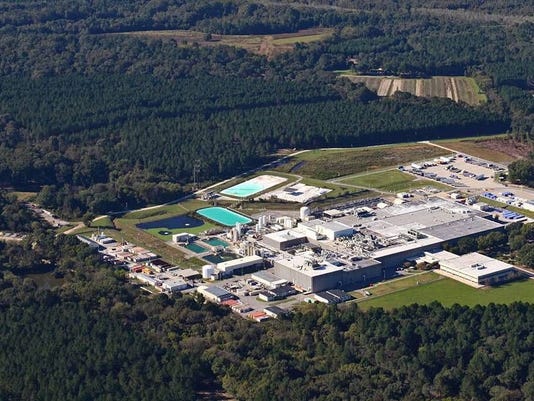
(Photo: Courtesy of High Flyer/The State)
BY SAMMY FRETWELL | greenvilleonline.com
Radioactive uranium has leaked through the floor at Westinghouse’s Bluff Road fuel factory, contaminating the soil in an area of Richland County with a nearly 35-year history of groundwater pollution from the plant.
The U.S. Nuclear Regulatory Commission says the uranium, a toxic substance used to make nuclear fuel rods, seeped through a 3-inch hole in a concrete floor in part of the factory where an acid is used. The hole extends 6 feet into the ground, according to the NRC. The NRC learned of the leak July 12.
Officials with the S.C. Department of Health and Environmental Control said they have no reason to believe the uranium has trickled off the site or that public water supplies are threatened.
However, the agency said it does not have the results of recent groundwater tests on the Westinghouse property. Those test results will show whether pollution in the soil washed into the area’s shallow groundwater, which seeps into creeks in the Congaree River flood plain.
NRC records show uranium pollution reached 4,000 parts per million in the soil beneath the plant. Those levels are 1,300 times higher than the amount of uranium typically found in soil, records show. Soil usually contains about three parts per million of uranium, according to the Health Physics Society, a radiation safety organization.
Tom Clements, an anti-nuclear activist who tracks issues at the Westinghouse plant, said government agencies need to explain how long the contamination went on and how much radiation has been released. The Westinghouse plant is several miles from Congaree National Park, a vast floodplain wetland renowned for its sparkling water and tall trees.
“It’s a pretty big concern if you have an unknown quantity of material containing uranium leaching into the groundwater,’’ Clements said.
Elevated levels of uranium in drinking water can increase a person’s risk of kidney damage,according to the U.S. Centers for Disease Control and Prevention. Over a lifetime of exposure, exposure to uranium also can increase a person’s risk of cancer, the agency says.
Roger Hannah, a spokesman for the NRC in Atlanta, said it does not appear the uranium has spread off the site, calling the contamination “very localized.’’ But he said the agency is investigating to learn more about what happened.
The recent uranium leak is the latest in a series of troubles at the plant.
Two years ago, Westinghouse had to shut down part of the plant after uranium built up in an air-pollution device. In 2017, a toxic solution sprayed a worker, forcing him to take decontamination measures. This year, the NRC cited Westinghouse for failing to ensure proper procedures were in place to limit a burst of radiation from occurring.
The company has pledged to do better, bringing in new management.
Westinghouse, which employs about 1,000 workers at the facility, also has had troubles with groundwater pollution at the site for three decades.
High levels of nitrate have been found in groundwater beneath the site since at least 1984, according to DHEC records. Those elevated levels prompted cleanup efforts, but nitrate remains in groundwater. Nitrate is particularly dangerous to infants who drink formula contaminated with the pollutant.
DHEC spokesman Tommy Crosby said the state agency is not concerned the pollution is a threat to public health. The agency said there are no public water supply wells within 2 miles of the Westinghouse plant and no private homes downstream from the plant.
“Based on existing information, there is no threat to the public from this recent release or from historical groundwater contamination at this secured site as there is no exposure risk to the general public,’’ Crosby said in an email this week.
NRC records show the leak occurred in a section of the plant that contains a hydrofluoric acid spiking station. The company found a hole in the floor while making repairs to a liner, according to the NRC. It then notified regulators of a possible “unauthorized discharge into waters of the state which may cause or contribute’’ to a violation of water-quality standards, NRC records show.
Westinghouse spokeswoman Sarah Cassella said the company has covered the hole in the floor with a metal plate and shut down chemical-processing equipment in the area. The company won’t begin using the station where the leak occurred until repairs are completed.
“Additional actions may also be completed once the investigation is complete,’’ Cassella said in an email to The State.
Westinghouse operates one of only a handful of nuclear-fuel factories in the United States. The company makes uranium-based fuel assemblies that are used to fire commercial nuclear reactors. The Westinghouse facility is up for a new federal operating license, but no decision has been made.
Separately, the company was the chief contractor on the failed $9 billion V.C. Summer nuclear plant expansion, northwest of Columbia, that was abandoned last summer.
